The first quarter of 2025 has been a particularly turbulent one for the financial markets: US equities had their worst relative performance in 23 years, Chinese markets rebounded, gold reached new highs and economic and geopolitical uncertainties fuelled volatility. Here are 10 charts that highlight the first three months of the year.
1. Fear of US Stagflation
Trade tensions have escalated in recent months, with the United States imposing tariffs on imports from Canada, Mexico, and China. This is likely to be expanded to a broader range of countries and goods. Trade frictions along with some specific factors such as the surge in US imports of gold bars have fuelled fears of an inflationary spillover.
For instance, the US 1-year inflation swap rose by 72 basis points in Q1, reaching 3.25%, the largest quarterly increase in three years. This upward pressure was reinforced by the latest PCE inflation data, the Fed’s preferred gauge, which showed the 3-month annualised rate of core PCE at 3.6% in February, its highest reading since March 2024.
The trade frictions also led to a pronounced deterioration in “real-time” gauges of US economic growth. US GDP projections have been revised lower by the Fed and most forecasters, and the recession probabilities, now at 35% according to Goldman Sachs, for the US has increased.
The other driver of the deterioration in Q1 growth estimates has been the drop in consumer sentiment, with gauges of current assessment and expectations falling with fears of higher tariff-driven inflation ahead.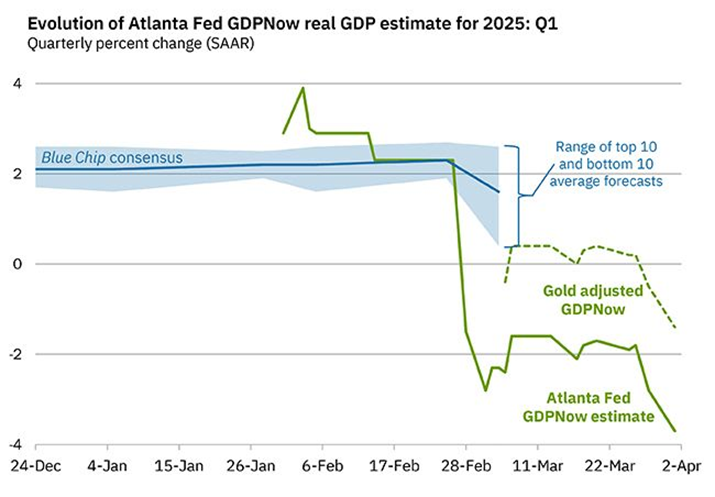
Source: AtlantaFed Nowcast
2. Central Banks In An Elevated Uncertainty Environment
Given heightened global uncertainty, the Federal Reserve opted to hold rates steady in Q1 and maintained its guidance for just two cuts in 2025, as its December stance. However, the Fed signalled a more cautious approach to liquidity withdrawal by slowing the pace of quantitative tightening, the monthly runoff of Treasury holdings is to be reduced from $25 billion to $5 billion starting from 1 April.
Across the Atlantic, the European Central Bank accelerated its easing cycle, delivering a 25bp rate cuts in both January and March, bringing the deposit rate to 2.50%. Markets are now pricing in an additional 60bp of cuts by the end of 2025. In contrast, the Bank of Japan continued its slow exit from ultra-loose policy, and delivered another rate hike in January, bringing the policy rate to 0.50% and signalling a willingness to pursue further normalisation ahead.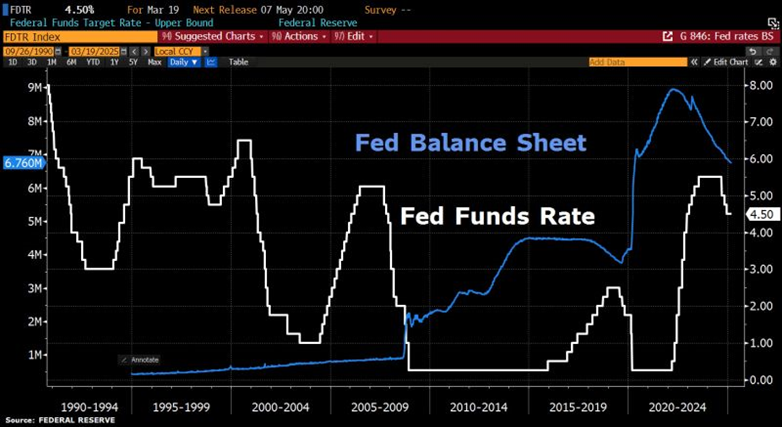
Source: Bloomberg, ZeroHedge
3. Worst Quarterly Performance For The S&P 500 Since Q3 2022
The first quarter of the year witnessed severe market turbulence in the United States. US equities delivered their worst quarterly performance relative to the rest of the world for 23 years. The Nasdaq-100 plunged -8.1% while the S&P 500 declined by -4.3%, its weakest quarterly performance since Q3 2022.
The so-called "Magnificent 7" had a historically poor start to the year, all members posting double-digit losses: Tesla (NASDAQ:TSLA) fell -29.98%, Nvidia (NASDAQ:NVDA) -17.77%, Alphabet (NASDAQ:GOOGL) -16.58%, Amazon (NASDAQ:AMZN) -10.66%, Apple (NASDAQ:AAPL) -10.59%, Microsoft (NASDAQ:MSFT) -9.34% and Meta Platforms (NASDAQ:META) -0.27% on a year-to-date basis. Yet, the sell-off was concentrated: 7 out of the 11 S&P 500 sectors remained positive YTD, suggesting this was particularly an AI and consumer discretionary correction.
The first catalyst came from the release of DeepSeek’s new AI model in January which sparked a sharp sell-off in mega-cap tech names and reignited concerns over the sustainability of U.S. big tech valuations and sparked doubts over the “US tech exceptionalism” narrative. The Nasdaq dropped -3.07% and Nvidia sank -16.97% on January 27 alone.
The broader correction, however, was driven by the wave of aggressive tariffs under President Trump, with trade tensions escalating beyond his first-term scope. Markets remain on edge as reciprocal tariffs are set to take effect in early Q2.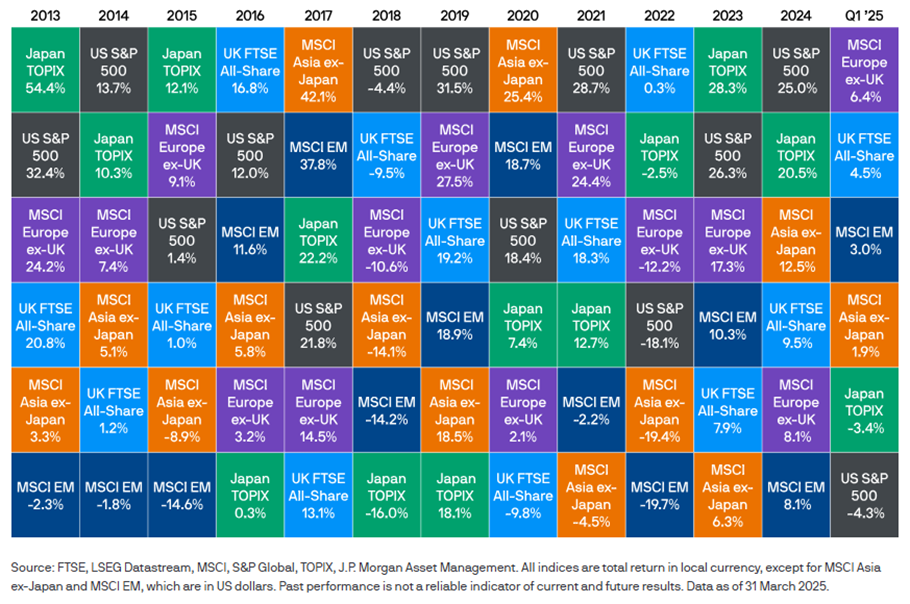
Source: World stock market returns, J.P. Morgan Asset Management
4. Warren Buffett’s Bet Pays Off
While the S&P 500 slipped into correction territory in Q1, Berkshire Hathaway’s (NYSE:BRKa) stock defied the trend, outperforming the market and reaching a new all-time high. Its Class B (NYSE:BRKb) shares now command a market capitalisation of $1.13 trillion, making it the only non-tech company to cross the $1 trillion threshold.
The company’s strong positioning is no accident. Warren Buffett had been a net seller of stocks for nine consecutive quarters during the bull markets of 2023 and 2024, amassing a record $334.2 billion in cash. This massive pile of cash has drawn investors in search of safe-haven assets during the current market volatility. Investor confidence was further boosted by February’s robust earnings report. The company reported a 70% increase in after-tax operating profits for Q4.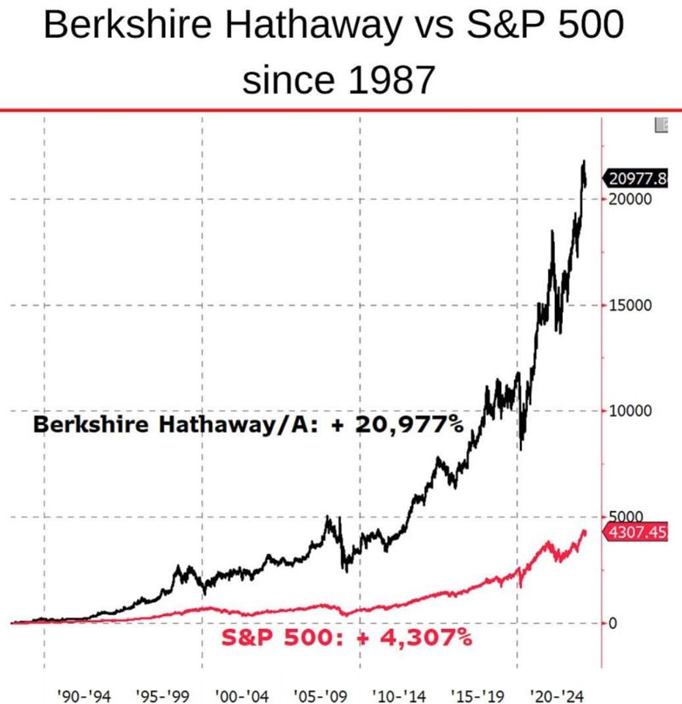
Source: Dividend Talks, YouTube
5. Make Europe Great Again
The final trading day of March brought the first monthly loss of the year for the Stoxx 600, down 4.18% according to LSEG data, as global markets reacted to the looming implementation of President Trump’s trade tariffs. Despite this dip, the European benchmark continues to outperform the US S&P 500 YTD, buoyed by a surge in defence-related stocks following renewed political momentum around military investment.
Fears that the US may scale back its NATO commitments have triggered a rally in European defence equities. This was further reinforced by European Commission President Ursula von der Leyen’s proposal of nearly €800 billion to strengthen the bloc’s defence capabilities. The plan includes €150 billion in fresh EU borrowing and €650 billion in additional fiscal flexibility, allowing member states to ramp up military budgets without breaching EU fiscal rules.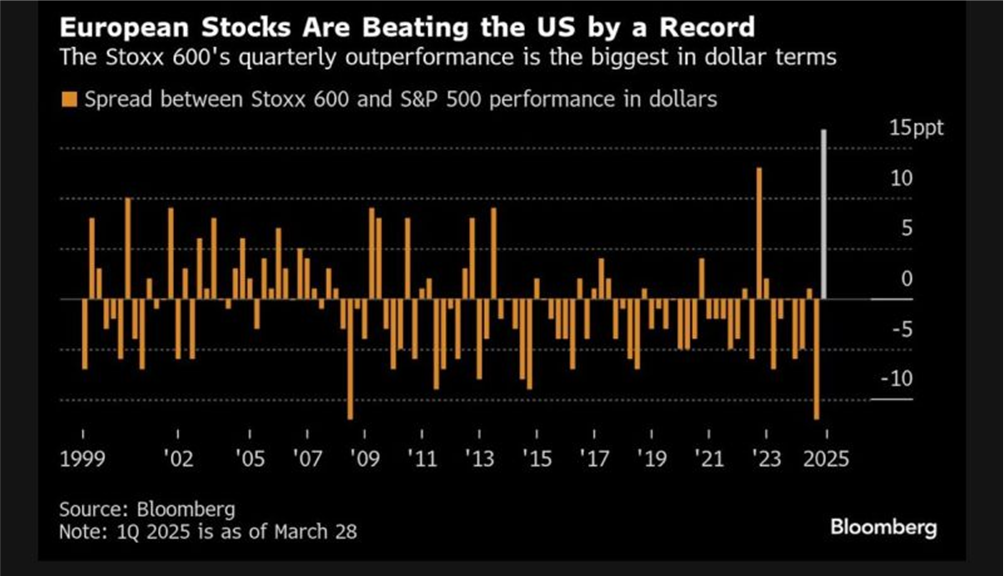
Source: Bloomberg
6. Momentum Returns To Chinese Markets
After a prolonged period of underperformance, Chinese equities rebounded in Q1, and the MSCI China Index surged nearly 16%. The renewed policy support from Beijing has helped restore investor confidence. Since autumn 2024, Beijing has implemented a series of stimulus measures aimed at stabilising the economy, supporting domestic consumption, and offsetting the weakness in exports. Some of the momentum may also reflect frontloaded manufacturing exports to the US ahead of anticipated tariff hikes.
Adding to the optimism is the breakout debut of DeepSeek’s R1, a generative open-source AI model viewed as a potential rival to OpenAI’s ChatGPT. Capable of solving complex tasks at a fraction of the cost of Western peers, R1 has reinforced confidence in China’s capacity to compete in the AI race.
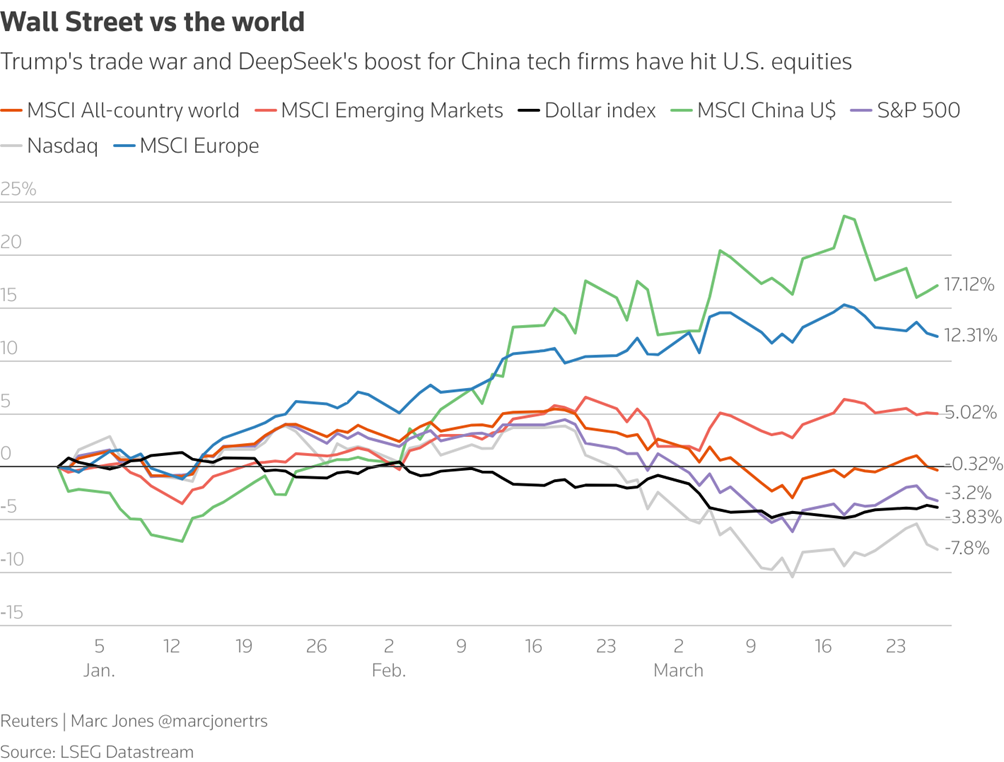
Source: Reuters
7. Fixed Income Performance
In the US, rising recession fears and easing inflation expectations drove a rally in government bonds, with Treasuries returning a respectable 2.9%. The 10-year yield fell 36 basis points over the quarter to 4.2%, as investors positioned for potential rate cuts later in the year.
In contrast, European sovereign bonds came under pressure, due to the prospect of increased government spending. German Bunds posted a -1.6% quarterly return, following Berlin’s decision to suspend its constitutional debt brake to finance expanded defence spending. The announcement triggered a sharp rise in Bund yields, up more than 30 basis points on the day, marking the biggest quarterly move since 2023 and the first time Bunds have diverged from Treasuries since 2021.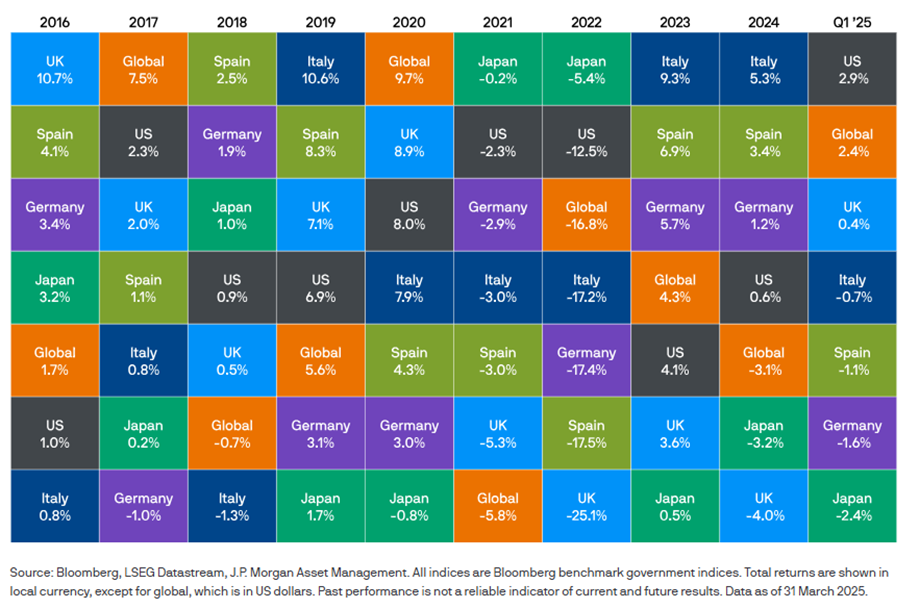
Source: Fixed Income government bonds, from J.P.Morgan Asset Management
8. Commodities Are The Winners Of The Quarter
Commodities were the top-performing asset class in Q1. Gold, long considered a safe haven asset, surged 18.8%, marking its best quarterly performance since 1986, driven by President Trump’s escalating trade war.
Oil prices fluctuated, influenced by fragile geopolitical developments in the Middle East and supply-demand dynamics. Copper jumped 11% as fears grew that new tariffs could hit the critical industrial metal. Soft commodities also saw strong upward pressure, raw arabica coffee surged 18%, nearly doubling year-on-year, driven by severe drought conditions that disrupted supply.
Looking ahead, Q2 is unlikely to bring much relief. With geopolitical tensions unresolved and policy uncertainty persisting, commodity market volatility is expected to remain elevated.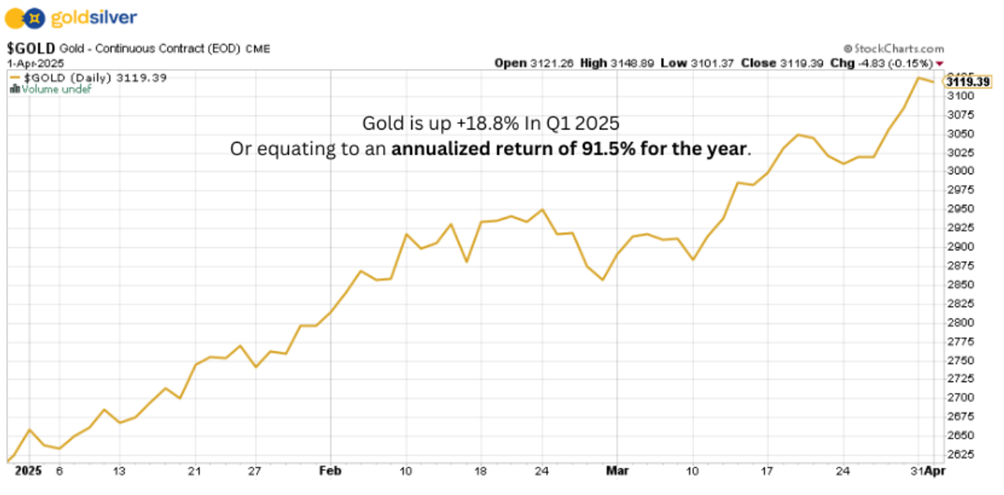
Source: Goldsilver
9. The US Dollar Under Pressure
The US dollar is off to its weakest start to a year since the 2008 financial crisis, the US Dollar Index (DXY) fell by nearly 4% in Q1. This broad decline has opened the door for emerging market currencies to outperform.
Even North American currencies, despite being caught in tariff crossfire, posted gains: both the Mexican peso and Canadian dollar ended the quarter in positive territory.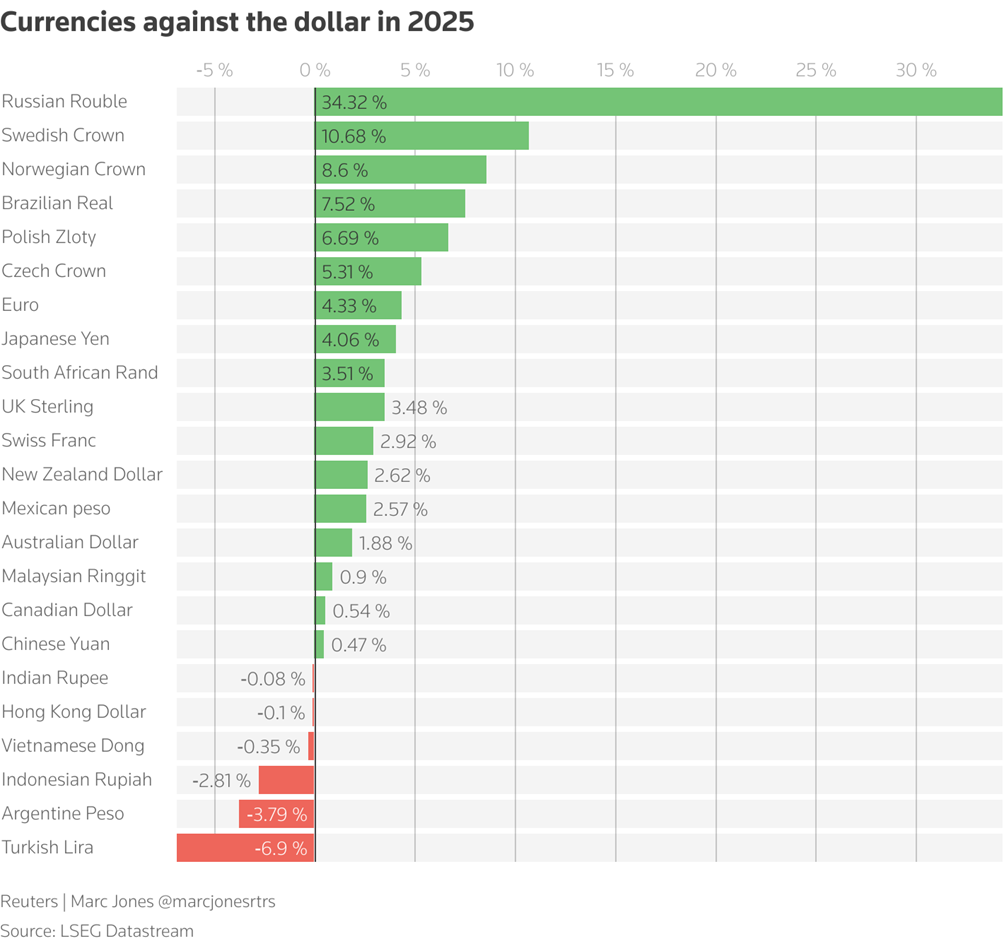
Source: Reuters
10. Ugly Quarter For Crypto
Cryptocurrencies endured a rough ride in Q1. Most major tokens posted losses for the quarter, led by a sharp 45% decline in Ethereum (ETH), which weighed heavily on the broader market.
Bitcoin remained volatile. It initially rallied nearly 20% following President Trump’s return to office, reflecting early optimism around his crypto-related agenda. However, that momentum faded quickly after his proposal for a US cryptocurrency reserve failed to convince markets. Bitcoin dropped nearly 30% from its highs and slipped below its 200-day moving average, though it remains above pre-election levels for now.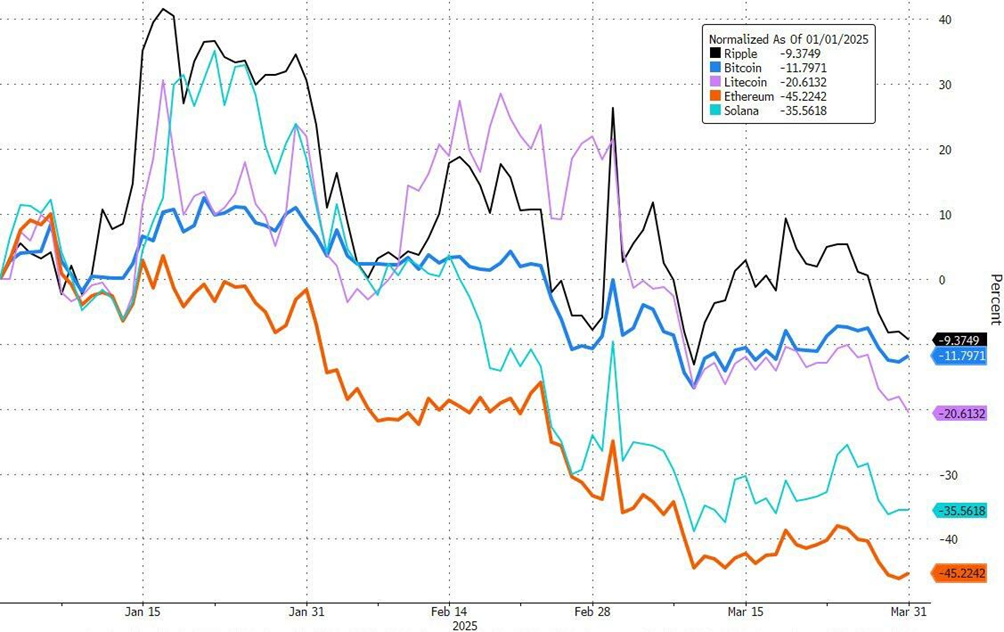
Source: Bloomberg
